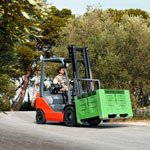In any line of work, the risk of injury in the workplace is always present. For forklift drivers it is imperat...
In any line of work, the risk of injury in the workplace is always present. For forklift drivers it is imperative to minimise that risk, especially when lifting heavy goods, which is an integral part of the daily operation of a forklift.
Toyota Material Handling Europe (TMHE) takes the safety of forklift operators and those around them very seriously. Through various innovations in truck design and safety programs, TMHE continuously attempts to reduce the dangers which forklift drivers are exposed to on a daily basis.
Forklift drivers should always keep in mind that safety is paramount, and they should never attempt to operate any truck that they are not licensed to. The best way to avoid any injury is to prevent risk to the fullest extent possible, and so every forklift operator should begin their day with a check of the truck to ensure that all the equipment is fully functional. The brakes and steering mechanism, as well as the horn, lights, and tyres should all be included in this safety check, and if any faults are found they should be reported immediately.
When leaving forklifts unattended for any length of time, brakes should be set and the controls should be neutralised. Before leaving the forklift, drivers must lower the forks and remove the key. Parking on any ramp or slope should be avoided unless absolutely necessary, but if it can’t be avoided, the breaks should once again be set and the wheels must be chocked.
During normal operation, it is important for drivers to keep their arms and legs inside the driver’s cabin at all times. When handling and lifting goods, unstable loads can be very hazardous. The safe working load weights should never be exceeded and loads should always be positioned at the heel of the forks to aid stability. The forks should never be used to transport people or raise them to a height.
Overturning is another of the dangers which drivers have to face when operating a forklift, and they should be aware that this is more likely to occur on bends and inclines. The Toyota System of Active Stability (SAS) helps to prevent this, but drivers should bear in mind that it is still a risk, especially in non-Toyota models. Controlling the speed of the truck is the best way to reduce the risk that the situation presents, so drivers should slow down at sharp curves and ramps, as well as on wet or slippery surfaces.
When driving, operators should take extra care and also curtail their speed when approaching aisle crossings or bends. Pedestrians tend to be particularly difficult to see when approaching these areas. Visibility is very important for forklift operators, and as such it is vital to always look in the direction of travel, especially when reversing. Areas of congestion and poor visibility can often be the cause of increased danger to the driver and those around them.
TMHE is proud to offer this guide to forklift operation as part of their commitment to safety in the workplace.
![]()







 粤公网安备 44010602003952号
粤公网安备 44010602003952号